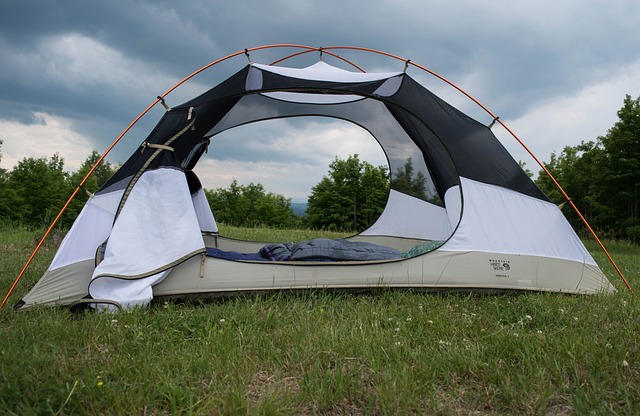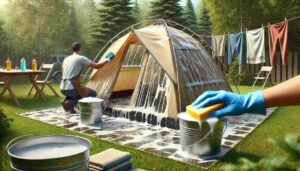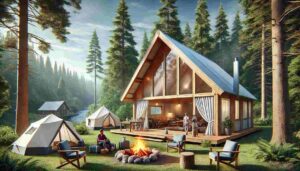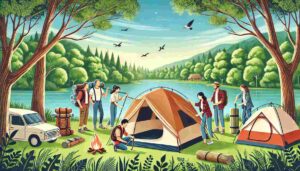Camping is a wonderful way to disconnect from the hustle and bustle of everyday life and enjoy the beauty of nature. Whether you’re an experienced camper or just starting out, one of the most important pieces of equipment you’ll need is a camping tent. However, with so many options available, it can be overwhelming to choose the right one for your needs. In this article, I’ll take a closer look at camping tents and provide a comprehensive guide to help you understand the materials and design features available. With this knowledge, you’ll be able to make an informed decision and choose the perfect camping tent for your next outdoor adventure.
Let’s get to it!
Tent Materials
When it comes to camping tents, there are several different materials to choose from. Each material has its own set of advantages and disadvantages, so it’s important to understand the differences in order to make an informed decision.
Types of Materials
- Nylon: Nylon is a popular material for camping tents due to its durability and lightweight. It’s also known for its water resistance, making it a great choice for camping in rainy conditions.
- Polyester: Polyester is another popular material for camping tents. It’s similar to nylon in terms of durability and weight, but it tends to be less water-resistant than nylon.
- Canvas: Canvas is a heavy-duty material that’s often used for larger camping tents. It’s incredibly durable and provides excellent protection from the elements, but it’s also heavier and more expensive than nylon or polyester.
Pros and Cons of Each Material
- Durability: When it comes to durability, canvas is the clear winner. However, nylon and polyester are also quite durable and can withstand a fair amount of wear and tear.
- Weight: Nylon and polyester are much lighter than canvas, making them a better choice for backpacking or hiking trips where weight is a concern.
- Breathability: Canvas is the most breathable material, which can be a major advantage in hot and humid conditions. Nylon and polyester tend to be less breathable, which can lead to condensation inside the tent.
- Cost: Canvas is the most expensive material, while nylon and polyester tend to be more affordable.
Tent Design Features
In addition to materials, tent design features are another important consideration when choosing a camping tent. There are several types of tents to choose from, each with its own advantages and disadvantages.
Types of Tents
- Dome: Dome tents are popular for their simple design and ease of setup. They typically have a rounded top and sloping sides, which provide good stability in windy conditions. They’re a good choice for camping trips where weight and pack size are a concern.
- Cabin: Cabin tents are larger and more spacious than dome tents, with straight walls and a flat roof. They’re a good choice for family camping trips or longer stays, as they offer plenty of room for people and gear.
- Backpacking: Backpacking tents are designed for lightweight and easy portability, making them a great choice for hikers and backpackers. They’re typically smaller and more compact than other types of tents, with a simple design that’s easy to set up.
Pros and Cons of Each Type
- Space: Cabin tents offer the most space, making them a good choice for families or groups of people. Dome tents and backpacking tents are smaller and more compact but still offer enough space for sleeping and storing gear.
- Weight: Backpacking tents are the lightest and most portable, making them a great choice for backpackers and hikers. Dome tents and cabin tents are heavier and bulkier but provide more space and comfort.
- Ease of Setup: Dome tents are typically the easiest to set up, with a simple design that’s easy to assemble. Cabin tents can be more difficult to set up due to their larger size and more complex design. Backpacking tents are designed to be lightweight and easy to set up, with fewer poles and a simpler structure.
- Weather Resistance: All types of tents can provide good protection from the elements, but cabin tents tend to be the most weather-resistant due to their sturdy design and strong materials. Dome tents and backpacking tents can still provide good protection, but may not be as sturdy in high winds or heavy rain.
Tent Capacity
Another important consideration when choosing a camping tent is capacity, or the number of people a tent can comfortably accommodate. While it may be tempting to go for the largest tent possible, it’s important to choose a size that fits your needs and provides adequate comfort.
Number of People a Tent Can Accommodate
Tent capacity is typically measured by the number of people it can accommodate. Common sizes include:
- 1-person: Designed for solo camping trips, 1-person tents are small and lightweight, making them a great choice for backpackers and hikers.
- 2-person: A 2-person tent is a good choice for couples or small groups of people. It provides enough space for two people to sleep comfortably and store their gear.
- 3-person: A 3-person tent is a good choice for small families or groups of friends. It provides enough space for three people to sleep comfortably and store their gear.
- 4-person or larger: Larger tents are a good choice for larger groups or families. They provide more space for people and gear but can be heavier and more difficult to set up.
Factors to Consider When Choosing the Right Size
When choosing a tent size, it’s important to consider the following factors:
- Comfort: Choose a tent size that provides enough space for everyone to sleep comfortably. Keep in mind that larger tents may be more comfortable, but they may also be heavier and more difficult to set up.
- Storage Space: Make sure there’s enough room in the tent to store your gear. A larger tent may be necessary if you have a lot of equipment or if you plan to spend an extended amount of time camping.
- Tent Weight: Consider the weight of the tent when packed and make sure it’s manageable for you to carry. If you plan on backpacking or hiking, a smaller and lighter tent may be necessary.
Tent Accessories
Tent accessories can enhance your camping experience and provide additional protection from the elements. Here are some of the most common tent accessories:
Footprints
A footprint is a groundsheet that goes under your tent. It provides an extra layer of protection from the ground, helping to prevent moisture and debris from seeping through the tent floor. Footprints are especially useful for tents without built-in floors or for camping on rough terrain.
Rainfly
A rainfly is a waterproof cover that goes over the tent to protect it from rain and other moisture. Some tents come with a built-in rainfly, while others require a separate rainfly. Rainflies are important for keeping you and your gear dry in wet conditions.
Guy Lines
Guy lines are ropes that attach to the tent and are used to stabilize it in windy conditions. They help prevent the tent from swaying or collapsing under strong winds. Guy lines are especially important for larger tents or in areas with high winds.
Vestibules
A vestibule is a covered area outside of the tent that provides additional storage space for gear. It’s especially useful for storing wet or dirty gear that you don’t want to bring inside the tent.
Tent Stakes
Tent stakes are used to secure the tent to the ground. They come in a variety of materials and designs, including plastic, metal, and spiral. It’s important to choose stakes that are appropriate for the type of terrain you’ll be camping on.
Tent Care and Maintenance
Proper care and maintenance of your camping tent can help extend its lifespan and ensure that it performs well on future camping trips. Here are some tips for caring for and maintaining your tent:
Cleaning Tips
- Sweep out the interior of the tent after each use to remove dirt, debris, and other materials that could damage the tent fabric.
- Use a mild soap and water solution to clean the tent fabric, and avoid using harsh chemicals that could damage the waterproof coating.
- Allow the tent to fully dry before packing it away to prevent mold and mildew growth.
Storage Tips
- Store your tent in a cool, dry place, away from direct sunlight, which can cause the tent fabric to deteriorate.
- Do not store your tent in a stuff sack for long periods of time, as this can cause the tent fabric to compress and lose its shape.
- Instead, store your tent loosely in a large breathable bag or hang it up in a cool, dry place to allow air circulation.
Repair Tips
- Inspect your tent before each use to check for any signs of damage, such as holes, tears, or broken zippers.
- Repair any damage as soon as possible to prevent it from getting worse.
- Use a patch kit to repair small holes or tears in the tent fabric, and replace any broken or damaged tent poles or stakes.
Conclusion
Choosing the right camping tent is an important part of any outdoor adventure. By understanding the different materials, design features, and capacity options, you can choose a tent that fits your needs and provides comfort and protection in a variety of weather conditions. Accessories such as footprints, rainflies, guy lines, vestibules, and tent stakes can enhance your camping experience and protect your gear from the elements. Proper care and maintenance, including cleaning, storage, and repair, can help extend the lifespan of your tent and ensure that it performs well on future camping trips. With the right knowledge and preparation, you can enjoy many memorable camping experiences with your trusty tent as your home away from home.









